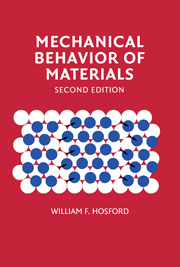Book contents
- Frontmatter
- Contents
- Preface
- 1 Stress and Strain
- 2 Elasticity
- 3 Mechanical Testing
- 4 Strain Hardening of Metals
- 5 Plasticity Theory
- 6 Strain Rate and Temperature Dependence of Flow Stress
- 7 Slip and Crystallographic Textures
- 8 Dislocation Geometry and Energy
- 9 Dislocation Mechanics
- 10 Mechanical Twinning and Martenitic Shear
- 11 Hardening Mechanisms in Metals
- 12 Discontinuous and Inhomogeneous Deformation
- 13 Ductility and Fracture
- 14 Fracture Mechanics
- 15 Viscoelasticity
- 16 Creep and Stress Rupture
- 17 Fatigue
- 18 Residual Stresses
- 19 Ceramics and Glasses
- 20 Polymers
- 21 Composites
- 22 Mechanical Working
- APPENDIX I Miller Indices
- APPENDIX II Stereographic Representation of Orientations
- Index
7 - Slip and Crystallographic Textures
Published online by Cambridge University Press: 05 June 2012
- Frontmatter
- Contents
- Preface
- 1 Stress and Strain
- 2 Elasticity
- 3 Mechanical Testing
- 4 Strain Hardening of Metals
- 5 Plasticity Theory
- 6 Strain Rate and Temperature Dependence of Flow Stress
- 7 Slip and Crystallographic Textures
- 8 Dislocation Geometry and Energy
- 9 Dislocation Mechanics
- 10 Mechanical Twinning and Martenitic Shear
- 11 Hardening Mechanisms in Metals
- 12 Discontinuous and Inhomogeneous Deformation
- 13 Ductility and Fracture
- 14 Fracture Mechanics
- 15 Viscoelasticity
- 16 Creep and Stress Rupture
- 17 Fatigue
- 18 Residual Stresses
- 19 Ceramics and Glasses
- 20 Polymers
- 21 Composites
- 22 Mechanical Working
- APPENDIX I Miller Indices
- APPENDIX II Stereographic Representation of Orientations
- Index
Summary
Introduction
Plastic deformation of crystalline materials usually occurs by slip, which is the sliding of planes of atoms over one another (Figure 7.1). The planes on which slip occurs are called slip planes, and the directions of the shear are the slip directions. These are crystallographic planes and directions that are characteristic of the crystal structure. The magnitude of the shear displacement is an integral number of interatomic distances, so that the lattice is left unaltered. If slip occurs on only part of a plane, there remains a boundary between the slipped and unslipped portions of the plane, which is called a dislocation. Slip occurs by movement of dislocations through the lattice. It is the accumulation of the dislocations left by slip that is responsible for work hardening. Dislocations and their movement are treated in Chapters 8 and 9. This chapter is concerned only with the geometry of slip.
Visual examination of the surface of a deformed crystal will reveal slip lines. The fact that we can see these indicates that slip is inhomogeneous on an atomic scale. Displacements of thousands of atomic diameters must occur on discrete or closely spaced planes to create steps on the surface that are large enough to be visible. Furthermore, the planes of active slip are widely separated on an atomic scale. Yet, the scale of the slip displacements and distances between slip lines are small compared to most grain sizes, so slip usually can be considered as homogeneous on a macroscopic scale.
- Type
- Chapter
- Information
- Mechanical Behavior of Materials , pp. 113 - 136Publisher: Cambridge University PressPrint publication year: 2009



